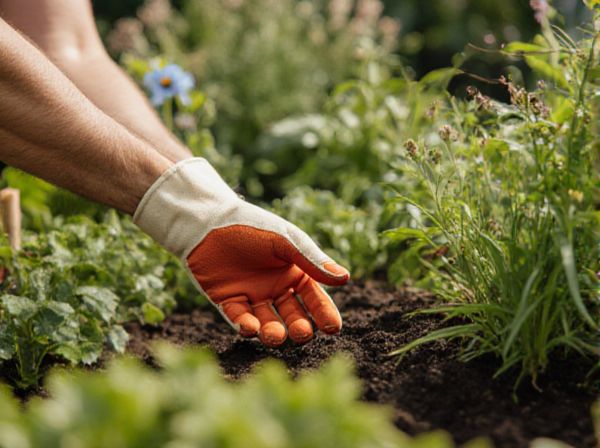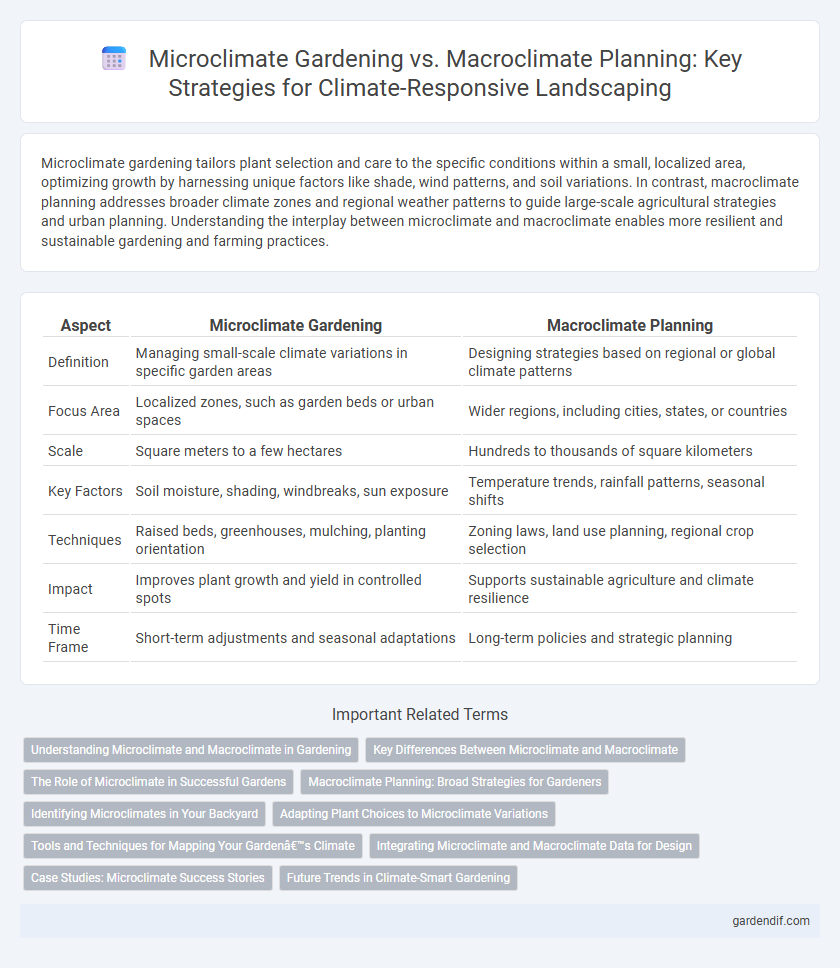
Microclimate gardening vs macroclimate planning Illustration
Microclimate gardening tailors plant selection and care to the specific conditions within a small, localized area, optimizing growth by harnessing unique factors like shade, wind patterns, and soil variations. In contrast, macroclimate planning addresses broader climate zones and regional weather patterns to guide large-scale agricultural strategies and urban planning. Understanding the interplay between microclimate and macroclimate enables more resilient and sustainable gardening and farming practices.
Table of Comparison
| Aspect | Microclimate Gardening | Macroclimate Planning |
|---|---|---|
| Definition | Managing small-scale climate variations in specific garden areas | Designing strategies based on regional or global climate patterns |
| Focus Area | Localized zones, such as garden beds or urban spaces | Wider regions, including cities, states, or countries |
| Scale | Square meters to a few hectares | Hundreds to thousands of square kilometers |
| Key Factors | Soil moisture, shading, windbreaks, sun exposure | Temperature trends, rainfall patterns, seasonal shifts |
| Techniques | Raised beds, greenhouses, mulching, planting orientation | Zoning laws, land use planning, regional crop selection |
| Impact | Improves plant growth and yield in controlled spots | Supports sustainable agriculture and climate resilience |
| Time Frame | Short-term adjustments and seasonal adaptations | Long-term policies and strategic planning |
Understanding Microclimate and Macroclimate in Gardening
Microclimate gardening involves tailoring plant selection and care to localized environmental conditions such as sunlight exposure, wind patterns, and soil moisture within a small area, often just a few square meters. Macroclimate planning considers broader climate zones defined by temperature ranges, precipitation levels, and seasonal variations that impact larger geographic regions. Understanding both microclimate and macroclimate factors enables gardeners to optimize plant health, increase resilience, and improve yields by aligning gardening practices with specific environmental variables.
Key Differences Between Microclimate and Macroclimate
Microclimate gardening targets localized environmental conditions, such as temperature, humidity, and wind patterns within a small area like a garden or urban block, enabling customized plant selection and care. Macroclimate planning considers broader regional climate patterns, including prevailing weather trends, seasonal changes, and long-term climate zones, which influence large-scale agricultural and urban development decisions. Understanding these distinctions allows for optimized plant growth strategies and sustainable resource management tailored to both immediate surroundings and wider climatic influences.
The Role of Microclimate in Successful Gardens
Microclimate gardening leverages localized climate conditions such as sunlight exposure, wind patterns, and soil moisture to enhance plant growth and resilience. By tailoring garden design to microclimatic factors, gardeners can create optimal environments that support diverse plant species and improve crop yield. Understanding microclimate variations within a broader macroclimate framework allows for precise planning, reducing stress on plants and ensuring long-term garden success.
Macroclimate Planning: Broad Strategies for Gardeners
Macroclimate planning involves assessing large-scale climate patterns such as regional temperature ranges, precipitation, and seasonal variations to inform garden design and plant selection. Gardeners utilize data from climate zones, frost dates, and prevailing wind directions to develop resilient landscapes that thrive under broader environmental conditions. Strategic choices include selecting drought-resistant species and optimizing soil management to ensure sustainability across changing macroclimate trends.
Identifying Microclimates in Your Backyard
Identifying microclimates in your backyard involves observing variations in sunlight, wind exposure, and soil moisture within small zones, which can differ significantly from the broader macroclimate of the region. Factors such as shaded areas under trees, heat-retaining walls, and low-lying spots prone to frost create unique conditions that influence plant growth and selection. Mapping these microclimates enables targeted gardening strategies that optimize plant health and yield by matching species to their ideal environmental niches.
Adapting Plant Choices to Microclimate Variations
Adapting plant choices to microclimate variations enhances growth by targeting specific environmental conditions such as temperature, humidity, and sunlight exposure within small garden areas. Microclimate gardening leverages localized factors like windbreaks, shade patterns, and soil moisture to select species that thrive in these niches, increasing resilience and yield. Contrastingly, macroclimate planning considers broader regional climate zones but may overlook these critical site-specific nuances essential for optimal plant performance.
Tools and Techniques for Mapping Your Garden’s Climate
Microclimate gardening employs detailed tools like soil thermometers, hygrometers, and infrared thermometers to measure specific conditions within small garden zones. Macroclimate planning utilizes broader techniques such as Geographic Information Systems (GIS) and climate modeling to analyze regional weather patterns and long-term climate trends. Combining data from on-site sensors with satellite imagery enhances precision in mapping microclimates and optimizing plant selection according to climate variation.
Integrating Microclimate and Macroclimate Data for Design
Integrating microclimate and macroclimate data enhances garden design by tailoring plant selection and placement to localized temperature, humidity, and sunlight variations within broader regional climate patterns. Advanced climate sensors and geographic information systems (GIS) allow precise mapping of microclimate zones, optimizing irrigation, shading, and soil management strategies for resilience against macroclimate extremes. This combined approach supports sustainable landscaping, maximizing biodiversity and resource efficiency amid climate variability.
Case Studies: Microclimate Success Stories
Microclimate gardening has proven effective in urban settings, as demonstrated by the New York City Green Roof Project, which reduced rooftop temperatures by up to 30%, enhancing local air quality and energy efficiency. In contrast, macroclimate planning, such as the Great Green Wall initiative across the Sahel region, addresses desertification by restoring 8,000 kilometers of degraded land, impacting regional climate resilience. These case studies highlight how targeted microclimate interventions complement broader macroclimate strategies to optimize environmental outcomes.
Future Trends in Climate-Smart Gardening
Climate-smart gardening increasingly emphasizes microclimate manipulation to optimize plant growth and resource efficiency, leveraging technologies such as smart sensors and adaptive irrigation systems. Macroclimate planning integrates broader climatic data and regional weather patterns to guide sustainable landscaping and crop selection, addressing larger-scale environmental challenges. Future trends focus on combining microclimate precision with macroclimate forecasting to enhance resilience against extreme weather and support biodiversity in urban and rural gardens.
Microclimate gardening vs macroclimate planning Infographic

 gardendif.com
gardendif.com